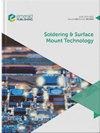热界面材料对InGaAlP小功率发光二极管光通量曲线的影响
IF 1.8
4区 材料科学
Q3 ENGINEERING, ELECTRICAL & ELECTRONIC
引用次数: 0
摘要
目的照明行业的一个主要问题是设备的热管理。从焊点到发光二极管(LED)封装环境的热阻处理与外部热管理有关,包括冷却模式的选择、散热器/基板和热界面材料(TIM)的设计。在增加LED系统的光输出的重要因素中,有效的基板和TIM。本工作研究了TIM对商用磷化铟镓铝(InGaAlP)低功率(LP)LED光通量性能的影响。设计/方法/方法一批LED直接安装在玻璃增强环氧树脂(FR4)和铝基金属芯印刷电路板(MCPCBs)的基板上,基板具有不同热导率的介电层。以类似的方式制备了另一批LED,但在LED封装和基板之间嵌入了一层TIM。TIM是导热环氧树脂(TCE)和导热粘合剂(TCA)。通过使用热瞬态测试仪集成系统(T3Ster)和LED在各种输入电流下的热辐射特性来测量LED参数。发现通过使用TIM,作者发现LED的最大光通量显著高于LED数据表中提到的值,并且热阻和结温显著降低。结果表明,对于热阻较低的系统,最大光通量出现在较高的功率水平。发现最大光通量分别为24.10、28.40和36.00 安装在FR4和两块MCPCB上的LED分别为lm。在LED上应用TCA后,FR4和MCPCB的最大光通量值分别为32.70、36.60和37.60 lm。此外,研究结果表明,安装在FR4基板上的LED的性能比MCPCB更受TIM的影响。研究局限性/含义照明行业的主要问题之一是设备的热管理。在许多低功率LED应用中,两个焊盘之间的气隙没有被填满。热流受到气隙的限制,导致热积聚和更高的热阻,从而导致更低的最大光通量。提高LED系统光输出的重要因素包括高效基板和TIM。实际意义本工作的发现可以作为一种方法,通过应用热界面材料来改善LP LED的热管理,从而提供更高效、更明亮的LP LED。使用铝基基材也可以提供类似的好处。社会含义LP LED的用户可以从这项工作的发现中受益。可以实现更明亮的汽车照明(信号和背光),更好的汽车照明可以为街上的人提供更好的安全,尤其是在雨天和雾天。用户还可以使用较低的LED额定功率来实现与具有较高额定功率的LED类似的亮度水平。独创性/价值通过使用热界面材料,实现了商用LP LED的更好热管理,从而降低了热阻、结温和LED亮度。本文章由计算机程序翻译,如有差异,请以英文原文为准。
Impact of thermal interface material on luminous flux curve of InGaAlP low-power light-emitting diodes
Purpose
One major problem in the lighting industry is the thermal management of the devices. Handling of thermal resistance from solder point to the ambiance of the light-emitting diode (LED) package is linked to the external thermal management that includes a selection of the cooling mode, design of heatsink/substrate and thermal interface material (TIM). Among the significant factors that increase the light output of the of the LED system are efficient substrate and TIM. In this work, the influence of TIM on the luminous flux performance of commercial indium gallium aluminium phosphide (InGaAlP) low-power (LP) LEDs was investigated.
Design/methodology/approach
One batch of LEDs was mounted directly onto substrates which were glass-reinforced epoxy (FR4) and aluminium-based metal-core printed circuit boards (MCPCBs) with a dielectric layer of different thermal conductivities. Another batch of LEDs was prepared in a similar way, but a layer of TIM was embedded between the LED package and substrate. The TIMs were thermally conductive epoxy (TCE) and thermally conductive adhesive (TCA). The LED parameters were measured by using the integrated system of thermal transient tester (T3Ster) and thermal-radiometric characterization of LEDs at various input currents.
Findings
With the employment of TIM, the authors found that the LED’s maximum luminous flux was significantly higher than the value mentioned in the LED datasheet, and that a significant reduction in thermal resistance and junction temperature was revealed. The results showed that for a system with low thermal resistance, the maximum luminous flux appeared to occur at a higher power level. It was found that the maximum luminous flux was 24.10, 28.40 and 36.00 lm for the LEDs mounted on the FR4 and two MCPCBs, respectively. After TCA application on the LEDs, the maximum luminous flux values were 32.70, 36.60 and 37.60 lm for the FR4 and MCPCBs, respectively. Moreover, the findings demonstrated that the performance of the LED mounted on the FR4 substrate was more affected by the employment of the TIM than that of MCPCBs.
Research limitations/implications
One of the major problems in the lighting industry is the thermal management of the device. In many low-power LED applications, the air gap between the two solder pads is not filled up. Heat flow is restricted by the air gap leading to thermal build-up and higher thermal resistance resulting in lower maximum luminous flux. Among the significant factors that increase the light output of the LED system are efficient substrate and TIM.
Practical implications
The findings in this work can be used as a method to improve thermal management of LP LEDs by applying thermal interface materials that can offer more efficient and brighter LP LEDs. Using aluminium-based substrates can also offer similar benefits.
Social implications
Users of LP LEDs can benefit from the findings in this work. Brighter automotive lighting (signalling and backlighting) can be achieved, and better automotive lighting can offer better safety for the people on the street, especially during raining and foggy weather. User can also use a lower LED power rating to achieve similar brightness level with LED with higher power rating.
Originality/value
Better thermal management of commercial LP LEDs was achieved with the employment of thermal interface materials resulting in lower thermal resistance, lower junction temperature and brighter LEDs.
求助全文
通过发布文献求助,成功后即可免费获取论文全文。
去求助
来源期刊

Soldering & Surface Mount Technology
工程技术-材料科学:综合
CiteScore
4.10
自引率
15.00%
发文量
30
审稿时长
>12 weeks
期刊介绍:
Soldering & Surface Mount Technology seeks to make an important contribution to the advancement of research and application within the technical body of knowledge and expertise in this vital area. Soldering & Surface Mount Technology compliments its sister publications; Circuit World and Microelectronics International.
The journal covers all aspects of SMT from alloys, pastes and fluxes, to reliability and environmental effects, and is currently providing an important dissemination route for new knowledge on lead-free solders and processes. The journal comprises a multidisciplinary study of the key materials and technologies used to assemble state of the art functional electronic devices. The key focus is on assembling devices and interconnecting components via soldering, whilst also embracing a broad range of related approaches.
 求助内容:
求助内容: 应助结果提醒方式:
应助结果提醒方式:


